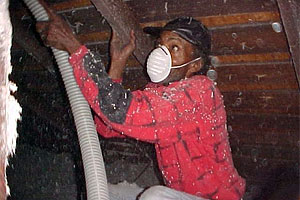 A Nebraska weatherization crew member
A Nebraska weatherization crew member
blows in dense-pack cellulose insulation into an attic.
(Photo by Pete Davis.)I am just back from the National Weatherization Training Conference in Orlando, Florida. The Weatherization Assistance Program is funded by the Department of Energy and other government agencies and serves low-income households in the United States. Weatherization professionals-- the ones meeting in Orlando-- are state workers and private contractors who spend a lot of time creeping around in crawlspaces and attics looking for ways to make the poorest homes in the nation more efficient and healthy to live in. People who are afraid of spiders, snakes, and rat droppings need not apply.
State agencies set guidelines on what retrofit measures contractors can perform and how much money they can spend on each home. Contractors in West Virginia work about 50% of the time on mobile homes. The usual retrofits includes attic insulation and duct sealing. Mobile home walls are usually not thick enough to make the time and effort needed to add wall insulation worth the investment. If standing in front of a window inside a home feels like standing in front of an open freezer, maybe new windows are called for, although the measurement of window leakage is a little more sophisticated than that. In some parts of California, however, the best return on investment (ROI) may be from replacing an old furnace and refrigerator. It all depends on the climate and the condition of the home.
One Colorado contractor says, "I don’t like spending $2,000 on a $1 home, but someone may be living there for another thirty years." And the work of a weatherization agency or contractor is never ending. There is always another home with back drafting furnaces that lead to dangerous levels of Carbon Monoxide inside, or mold run amok in another mobile home, or another elderly couple ready to freeze to death in the next hard winter.
If I sound like I admire these people and the work they do and in fact consider them heroes, it's because I do. For every dollar they spend they save an average of two dollars. In my experience, the weatherization community is also the most diverse segment of the green building movement. Some weatherization professionals may be partial to fried food and domestic beers, and some may even vote Republican, but they were doing green building and renovation before it was given a color.
![]() Jim Gunshinan is Managing Editor of Home Energy Magazine. He holds an M.S. in Bioengineering from Pennsylvania State University, State College, Pennsylvania, and a Master of Divinity (MDiv) degree from University of Notre Dame.
Jim Gunshinan is Managing Editor of Home Energy Magazine. He holds an M.S. in Bioengineering from Pennsylvania State University, State College, Pennsylvania, and a Master of Divinity (MDiv) degree from University of Notre Dame.
